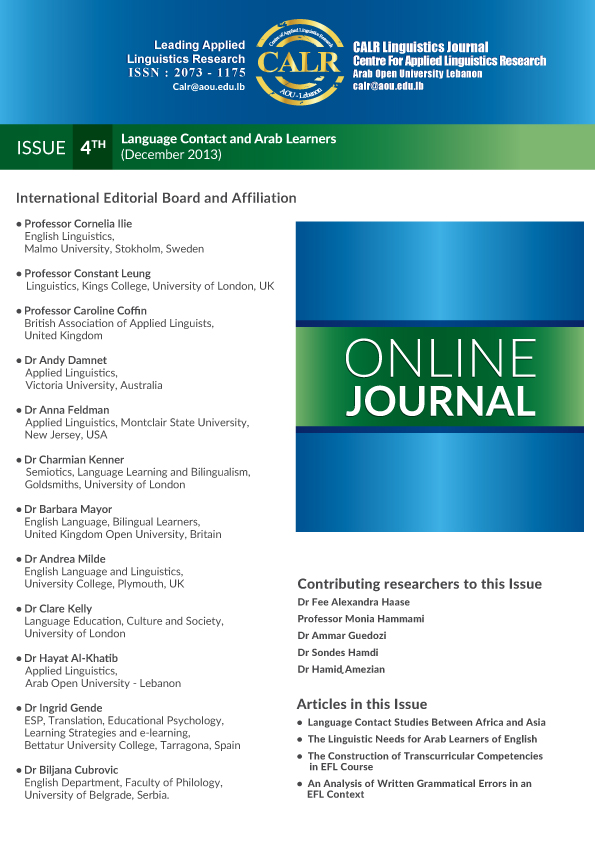
DOI: https://doi.org/10.60149/YDLB4995
An Analysis of Written Grammatical Errors of Tunisian Learners of English in EFL Context
Author: Dr Sondes Hamdi Assistant Professor of Linguistics ISEAH institute of Kef – Tunisia sondeshamdi@yahoo.fr
Abstract: This study investigated grammatical errors in a corpus of 18 essays written by 18 participants. The participants were third-year Tunisian students who were studying business English at the ISEAH Institute of Kef in Tunisia. They had experienced approximately the same number of years of education through primary, secondary and university education in Tunisia. All of the participants came from non-English speaking backgrounds and seldom communicated in English outside the school. The instrument used for this study was participants’ written essays. All of the grammatical errors in the essays were identified and classified into various categorizations. The results of the study show that the most pervasive errors committed by the participants were tenses, morphology, prepositions, articles, verbs, and relative pronouns. This study has shed light on the process through which students internalize the grammatical rules of English as a target language. Such a study of language learning difficulties is useful to teachers because it tells about frequent “trouble-spots” in language learning which can be employed in the preparation of efficient teaching materials. Keywords: Error analysis, grammar, English, Arabic, interference, acquisition.Key Words: Multilingualism, Linguistic and Cultural diversity, Educational policy, School improvement
Download link:Article 1 (PDF)
DOI :https://doi.org/10.60149/DQXX3250
Linguistic Needs for Arab learners of English
Author: Professor Monia Hammami Faculty of Letters, Arts, and Humanities
University of Manouba-Tunisia
[monia.hammami@flm.rnu.tn]
Abstract: Language shapes both how we understand and how we negotiate our world; learning a second language provides both a deep awareness of differences (linguistic and cultural) and a means to bridge them. Linguistics needs and requirement of the second language L2 give communicative capacities to the learners, and the study of foreign languages fosters precisely these capacities. The subject of linguistic needs analysis (LNA) has not yet received sufficient attention from researchers and language teaching professionals in the Arab world. As a result, Arab learners rarely have input in their language teaching context. This paper is an attempt to draw the attention of educators, language teaching professionals, and other interested parties to the dilemma of a large number of the Arab learners of the English. Students are not adequately prepared, from a linguistic point of view, to pursue their university education with a great deal of efficiency. The core of the problem lies in the pre-packaged language teaching curricula that are usually imported for the students and are not based on their needs. In this paper we will shed some light on this subject by offering a generic and critical reflection on some of the LNA-related educational ailments that are ubiquitous in the Arab world. I will begin with a brief theoretical introduction about the concept of linguistic needs analysis and present two LNA taxonomies that, if implemented, should provide English language instructors with a well-rounded idea about their learners' needs. Then, I will draw on my life-long experience as a language teaching professional and professor of English Arabic translation to the graduate and post graduate students, in order to provide a generic and critical examination of LNA in the Arab world. Finally, I will present some recommendations that may help educators and other interested parties to improve the process of foreign language instruction for Arab learners' of English needs.
Key Words:second language L2, linguistic needs analysis, LNA taxonomies, process of foreign language
Download link:Article 2 (PDF)
DOI: https://doi.org/10.60149/UMYM1167
The Construction of Transcurricular Competencies in Algerian EFL Course: A Textbook Analysis
Author: Dr Amar Guendouzi and Dr Hamid Ameziane
Department of English Studies University of Tizi Ouzou, Algeria
guendouzi@yahoo.fr amezianeham@yahoo.fr
Abstract: his paper looks into the implementation of the interdisciplinary curriculum in Algerian EFL course from the perspectives of both broad areas of learning and learning process. It analyses two textbooks, Spotlight on English Book 3 and Getting Through, belonging respectively to the middle and secondary school levels. The analysis shows that the designers have adopted the Interpretation, Constructivist Design (ICON) Model (O’Mallet and Chamot 1990) and restricted its use to the strategy of generating and testing hypotheses. Our main findings underscore the constructivist orientation of the curriculum and underline three important flaws in the textbooks: one, the activities are not purposive in questioning for information and cooperation; two, the generating strategy serves as a learning strategy rather than as a learning process; three, the stages of multiple interpretations and manifestations are rarely attained, leaving little opportunity for knowledge transfer to real life contexts. .
Download link:Article 3 (PDF)
DOI: https://doi.org/10.60149/RAHL7446
Language Contact Studies between Africa and Asia Arabic and the Ancient Egyptian Language: An Approach of the Configuration of the History of Language Development Exemplified by Strata of the Afro-Asiatic and Semitic Language Families
Author: Dr. Fee-Alexandra Haase
F.a.haase@gmx.de
Am Sportplatz 2 D-18573 Rambin Germany
Abstract: This article is interested in the development of language as a human feature and a historical development linguists classify using specific classifications of ‘strata’ to indicate dominant and recessive language types in language contact situations. The influence of the ancient Egyptian language, which had words, that we can still find with slight phonetic changes in contemporary Arabic is a paradigm for the study in the development of language. But these linguistic findings are also the ground for questioning the positions and theories on mainstream research positions. This discussion we will have after the presentation of our findings. The corpus of this study consists of 2900 entries in the Project Tower of Babel of Semitic words. The words of this corpus that have a corresponding word in contemporary Arabic are presented. The distinction between the Afroasiatic and the Semitic language families is a basic assumption in linguistics. Egyptian is classified as an Afroasiatic language, while Arabic is a Semitic language..
Download link:Article 4 (PDF)
DOI: https://doi.org/10.60149/HRXU2241
